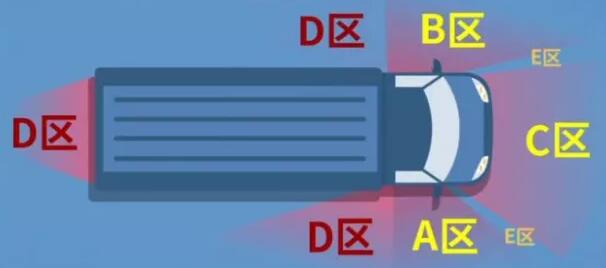"Mandatory Stops" for Large Trucks during Right Turns
Let's first understand the blind spots of trucks with the help of a diagram.
Areas A, B, and C in the image represent semi-blind spots, located approximately 1.5 meters to the right front, 1.2 meters to the left front, and directly ahead at 1.2 meters from the truck, respectively. Areas D and E represent full blind spots, situated at the left, right, rear of the cargo compartment, and two locations blocked by the windshield's A-pillar at the front.
Among these blind spots, the most perilous is the truck's right side, specifically from the cargo end to the driver's cabin end. During truck turns, the discrepancy in the tracks of the front and rear wheels leads to "inner wheel offset." Pedestrians, non-motorized vehicles, or other small motor vehicles entering this area during turns could result in tragic accidents.

Despite many trucks being equipped with blind spot sensors, alarms, and various intelligent sensors, accidents involving casualties due to right-turn incidents still occur frequently. Reports indicate that in severe traffic accidents involving large vehicles, incidents triggered by inner wheel offset account for over 70%, with a mortality rate exceeding 90%.
As these tragedies persist, they have garnered heightened attention from various departments and authorities. Many cities have initiated "new measures" to further strengthen safety precautions.
S city has begun enforcing "mandatory stops for container truck right turns," requiring container transport companies to strictly implement this measure. Failure to comply may result in regulatory actions such as being blacklisted. Additionally, they have mandated "mandatory stops for right turns by large trucks" at 43 intersections, with offenders facing fines. Several months earlier, S city implemented the "mandatory stops for right turns by large vehicles" policy across the board.
Some cities have installed "blind spot sweepers" at intersections for right-turning large trucks. These devices consist of two sets of convex mirrors, a right-turn parking observation area, and isolation barriers. The intention, similar to right-turn stops, is to further eliminate safety hazards caused by truck right-turn "blind spots."
"Mandatory stops" imply that large trucks must halt and observe the road conditions before making a right turn to ensure safety before proceeding.
This allows drivers ample time to assess the situation and serves as a reminder for pedestrians and non-motorized vehicles during right turns, providing everyone involved in the traffic enough reaction time. In theory, this regulation should help reduce accident rates to a certain extent.
Simultaneously, there is a need to enhance public awareness regarding the blind spots of trucks. Pedestrians, cyclists, or drivers of small motor vehicles should cultivate the habit of actively staying away from truck blind spots.
Contact: Mr.Tom
Phone: 0086-755-85279352
E-mail: sales@szjeavox.com
Add: FL7-8,4 Bldg,Honghui Industrial Park,Liuxian 3 Rd,68 Zone,Bao'an,Shenzhen, China